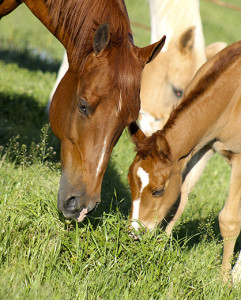Spring Grass is Coming- is Your Horse Ready?
FLINT HILL, Va., Jan. 9, 2015 – Lush, spring grass is just around the corner. While the horses will be chomping at the bit to start grazing, any horse person will tell you that it’s imperative to manage a horse’s time on the green stuff. For horses with metabolic issues, management is even more important.
The reason is simple. Insulin allows glucose, or sugar, to be burned as fuel. Horses that are insulin resistant (IR) have a difficult time using the glucose, so it’s stored as fat.
“Horses with metabolic issues are even more susceptible to the high level of sugars (which are mostly fructans) in spring grass,” said integrative and complementary veterinarian Dr. Joyce Harman, founder of Harmany Equine. “If the sugars pass into the hind gut before they’re digested, they can kick off a process that will cause laminae to fail, leading to a laminitic attack.”
Spring grass doesn’t have to spell disaster for horses, though. Here, Dr. Harman offers strategies to keep horses healthy and happy:
1. Regulate Sugar Intake: From the spring grass to hay and grain, sugar is all around our horses. It’s the responsibility of the horse owner to keep the horse from overdosing. Here’s how:
– Graze the horses in the morning or on cloudy, rainy days when fructans are lower.
– Get your hay tested. Late-cut hay is usually lower in sugar content.
– Read grain labels! Avoid grain with added sugar, like molasses, and consider feeding unprocessed grain like oats or barely.
2. Grab a Muzzle: Muzzles allow a horse to behave normally in the pasture in terms of exercise and socialization without running the risk of over-grazing.
Dr. Harman recently designed a state-of-the art muzzle that is totally customizable, from molding it to a horse’s head shape to determining how much, or how little, grass is available to a horse. Her Harmany Muzzle is also made of a medical grade plastic with Kevlar fibers, making it much lighter than other available muzzles without sacrificing durability. Visit her website to learn more.
3. Supplement Your Horses: Some vitamins, fats and minerals help improve insulin resistance by helping turn sugar into useable energy. Dr. Harman commonly prescribes flax, magnesium, chromium and vanadium for horses that are IR. Some of her favorite supplements are:
– Omega 3 fatty acids (flax, hemp, chia seeds): These all help regulate sugar metabolism, making it safer for horses to be exposed to grasses. These are a key ingredient in any equine weight loss program, as well as for any horse with IR.
– Milk Thistle: This herb has always been known for its effects on the liver, but current research shows that it is very useful for IR. You can get milk thistle extracts at most health food stores. Use 2-3 times the human dose when dosing an equine.
– Vanadium: This mineral is often overlooked in treating IR horses, yet some respond much more noticeably to vanadium than they do the popular chromium.
4. Take Advantage of Homeopathic Remedies: No matter how cautious we are, accidents happen. If your horse has overeaten, Dr. Harman commonly prescribes two homeopathic remedies:
– Nux Vomica can be used for three to five days. It helps the horse’s metabolism deal with the overload of sugars, and seems to help remove some of the inflammation caused by, and can be purchased on Dr. Harman’s website.
– Aconite can be used if a horse is beginning to get suddenly sore after spending time on grass. It can be given for two to three days, and can also purchased on Dr. Harman’s website.
– Dr. Harman recommends dissolving six to eight pellets with in a syringe, and dosing once or twice daily.
To learn more about natural and holistic treatments for IR and laminitis and how to avoid issues, check out this paper written by Dr. Harman.
ABOUT JOYCE HARMAN
Dr. Joyce Harman opened Harmany Equine Clinic, Ltd in1990, bringing holistic healing to horses from all walks of life, backyard retirees to Olympic competitors. Over the years, Dr. Joyce Harman has observed and adapted to the changing needs the industry. Twenty-plus years ago, no one had heard of Lyme disease or Insulin Resistance, yet today that makes up a large part of her clinical practice.
In 2001, she wrote the first paper in a peer-reviewed journal about the possibility that horses have insulin resistance (IR), and now it is part of our every day conversation. In 2004 she published the first comprehensive book on English saddle fitting since the 1800’s, with the western version of the book following in 2006. To this date, these books are the only books written by an author who is independent from a saddle company, which brings unbiased information to the horse world.











